GOLDEN HOUR QUIETNESS
Huberto Pimentel of East Setauket captured this crisp clear image at the Setauket Harbor Marina on Oct. 21 around 4 p.m. during ‘a quiet getaway moment.’
Send your Photo of the Week to [email protected]
GOLDEN HOUR QUIETNESS
Huberto Pimentel of East Setauket captured this crisp clear image at the Setauket Harbor Marina on Oct. 21 around 4 p.m. during ‘a quiet getaway moment.’
Send your Photo of the Week to [email protected]
Setauket Harbor and its surrounding area will be a bit cleaner due to a grant secured by a state senator.
“Long Islanders are fortunate to have access to natural resources like the Setauket Harbor and we must continually fight to preserve them.”
— Sen. John Flanagan
Sen. John Flanagan (R-East Northport) secured a $1 million grant from the state for the Town of Brookhaven in 2016 to be used to improve water quality in Setauket Harbor, which will also help clean out the pond slightly west of Se-Port Delicatessen on Route 25A and fix the dock on Shore Road. While the grant was secured two years ago, the contract period began Oct. 1.
“Long Islanders are fortunate to have access to natural resources like the Setauket Harbor and we must continually fight to preserve them,” Flanagan said in a statement. “That is why projects like this are so important, and it is my pleasure to work with the Setauket Harbor Task Force as well as the Town of Brookhaven to ensure that this beautiful natural resource is protected. These fragile ecosystems are so critical to every facet of life for the people who live, work and play in our region, and it is imperative that we continually join together to make sure they are available to future generations of Long Islanders.”
Veronica King, the town’s stormwater manager, explained how the money would be put to use.
“The project has three distinct components — repair the failing bulkhead at the Shore Road park, remove sediment from the retention pond at [East] Setauket Pond Park, and implement stormwater improvements to mitigate stormwater inputs into the harbor,” she said.
King said the work will take approximately three years to complete and a professional engineering firm will be hired to assist with design, permitting and construction.
“If we don’t fix the pond, we’re just kind of spitting into the wind in terms of all the other stuff we do.”
— George Hoffman
Members of Setauket Harbor Task Force, an organization created with the goal to improve water quality in the harbor, have been consulting with the town about the project, according to task force co-founder George Hoffman.
He said the largest source of pathogens in the harbor are most likely from stormwater from the pond.
“If we don’t fix the pond, we’re just kind of spitting into the wind in terms of all the other stuff we do,” he said.
Hoffman said the pond near the delicatessen serves as an inlet to Setauket Harbor, and stormwater from Route 25A — from around the fire station northeast to the water — washes into it. Hoffman said the pond’s old, faulty water treatment structure is allowing sediment to build up and currently stormwater is going straight into the harbor. He said sediment can include sand that’s been put down on the roads in the winter, items that fall off trucks and cars and pet waste.
“The town has a strong commitment to protecting our natural environment.”
— Veronica King
Hoffman said the goal is to dredge the pond and remove 10 feet of sediment. He said the reconstruction of the stormwater inputs would enable the sediment to go into a catch basin that’s specifically designed to capture it. The sediment will settle and then only water would go into the harbor.
King said the town will contribute $500,000 worth of capital funds, bringing the total allocation to the project to $1.5 million.
“The town has a strong commitment to protecting our natural environment,” she said. “It makes it so much easier when we have the community’s support for projects such as the Setauket Harbor project.”
The town will also need to get approval from the New York State Department of Environmental Conservation before removing the sediment, which is standard DEC procedure as at times it may contain toxins. King said it shouldn’t be a problem as the town recently did a grain size analysis and found a high percentage of coarse sand material, and she doesn’t expect any surprises as far as chemical compounds.
Hoffman said he looks forward to the improvements as many people attending the Route 25A Visioning meetings in 2017 pointed to the area around the harbor as having potential.
“We see it as the first phase,” he said. “I think we have some plans to make it the centerpiece of downtown East Setauket.”
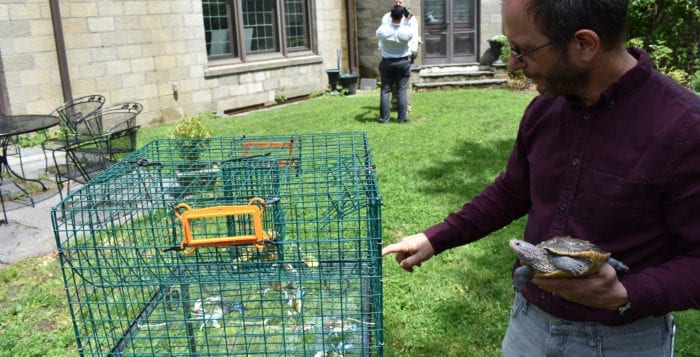
It has been a slow crawl saving Long Island’s turtles, but local conservation groups are hoping new state regulations will speed up the process.
The New York State Department of Environmental Conservation and Long Island environmental groups gathered May 23 at the Suffolk County Environmental Center in Islip to celebrate new rules requiring crab cages — used in Long Island’s coastal waters including many of the bays, harbors and rivers that enter Long Island Sound — to have “terrapin excluder devices” (TEDs) on all entrances. As carnivores, terrapins are attracted to bait fish used in commercial, or what’s known as Maryland style crab traps or “pots.” As a result, male and female turtles of all sizes push their way through the entrance funnels and end up drowning.
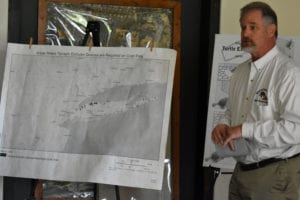
“With each and every season these traps are not required to have TEDs, there are likely hundreds of terrapins that are drowning,” said John Turner, conservation policy advocate for Seatuck Environmental Association, which operates the Islip center. “To me, one of the signs of a real civilized society is how we treat other life-forms. We haven’t treated terrapins very well.”
He said in Stony Brook Harbor alone there are dozens, maybe hundreds of terrapins that will spend the winter in the mud, emerging once the water runs up high enough. Turner said many of the North Shore areas that are home to these turtles, like Setauket Harbor, Conscience Bay, Port Jefferson Harbor, Mount Sinai Harbor and Nissequogue River, play a key role in preserving the species.
“In contrast to where I am in South Jersey, I can go by the canals and I can see a dozen [terrapin] heads bobbing up and down,” said James Gilmore, director of the marine resources division at the state DEC. “Here, it’s very rare to see one. Hopefully these new rules will help us see more.”
Gilmore said the DEC began working on changing state regulations in 2013 but have known long before there was a problem.
Carl LoBue, The Nature Conservancy’s New York ocean program director, said it was in the late 1990s he’d witnessed recreational crab traps in Stony Brook Harbor. One day he lifted a cage out of the water while trying to move his landlord’s boat and saw it was filled with trapped terrapins. Two were still alive, but five
had already drowned.
“With each and every season these traps are not required to have TEDs, there are likely hundreds of terrapins that are drowning.”
— John Turner
“I’m sure the crabber wasn’t intent to kill turtles,” LoBue said. “But when I looked across the bay at the 60 or something crab traps this person had set, I was crushed thinking of the terrapins drowning at that very moment.”
In the early 2000s terrapins became a popular meal in New York, but the harvest of those turtles led to a massive decrease in population, especially the diamondback terrapin, which was identified as a species of greatest conservation need in the 2015 New York State Wildlife Action Plan. In September 2017 the DEC passed regulations banning the commercial harvest of diamondbacks.
Terrapin population has slowly increased since then, but researchers say there’s still little known about the population, like life expectancy or habits while in water. The species has a very slow birth rate, with low local clutches of 10 or so eggs — sometimes only one or two of which hatch and mature.
Russell Burke, a professor of biology at Hofstra University, said terrapins could live very long lives, pointing to older specimens he has seen living to 60 years old, but he estimated some could be twice that age. While Burke said it’s hard to estimate the total population on Long Island, he said in Jamaica Bay alone, he knows there are approximately 3,500 adult females.

The TED devices are 4 3/4 inches by 1 3/4 inches, an exact measurement, to ensure that while crabs can get through, turtles cannot. According to Kim McKown, leader of the Marine Invertebrate and Protected Resources Unit at the state DEC, the small, plastic TEDs cost $10 for the three needed to secure a normal crab trap. The cost exponentially increases depending on how many traps a fisherman has, with some owning up to 1,000 traps.
Turner said his organization used its own funds and purchased 5,000 TEDs and gifted them to the DEC. The state agency is giving them to Long Island crab fishermen on a first come, first served basis.
Commercial crab fisherman Fred Chiofolo, who hunts in Brookhaven Town along the South Shore, experimented with TEDs on his own for years before the regulations were passed. He said the devices
even improved the number of crabs caught.
“It made a significant difference with the pots that had them versus the pots that didn’t,” Chiofolo said. “Last year I put them in every pot I had — about 200 of them. I’m not going to lie it’s a lot of work to put them in, but we don’t want to catch the turtle. I don’t want them, and [the TED] does keep them out.”
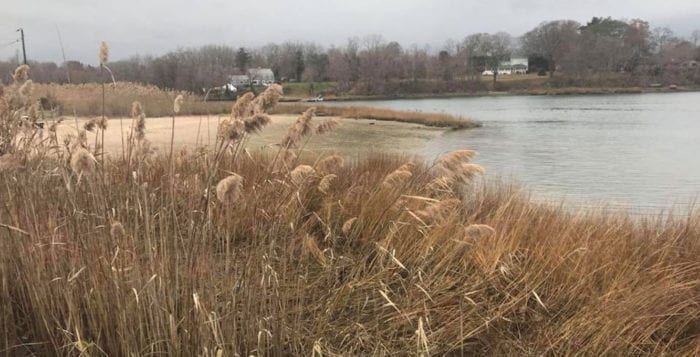
Residents in the vicinity of Setauket Harbor are crying “fowl” when it comes to the shooting of ducks and geese on the waterway and are hoping to change local hunting laws.
Early in December, a post on the Facebook page Three Village Parents generated a lot of buzz. Many residents near Setauket Harbor reported seeing hunters and hearing shotguns in the area. One resident commented that she had seen pellet holes in her window, while another said she changes her jogging route during hunting season, which runs until Jan. 28 for ducks and Feb. 26 for geese.
Waterfowl hunting is legal in the state. According to the New York State Department of Environmental Conservation, the agency promotes it as both a recreational sport and wildlife management tool. Those wishing to hunt waterfowl can do so during open seasons as long as they possess a valid hunting license, migratory bird stamp and Harvest Information Program number. Despite the laws, local residents aren’t happy with the early morning noises and feel the nearby hunting is a threat to their safety.
Tami Robitsek said she was sitting in her car the morning of Nov. 15 at Shore Road beach in East Setauket when she heard a loud gunshot and noticed two men in camouflage with shotguns hiding in the reeds on the beach. Robitsek said she felt it posed a dangerous situation as she witnessed several people walking and running along the road, a school bus filled with children, a man working on his boat moored off the shore and an elderly woman crying just off the road after hearing the shots.
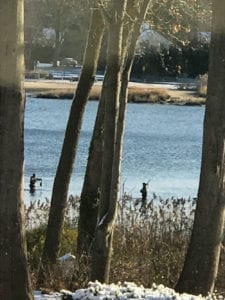
“After this jarring experience, I am committed to working to end duck hunting in Setauket Harbor,” Robitsek said.
The East Setauket resident is rallying her neighbors and recently created the Facebook group, End Duck Hunting in Setauket Harbor, which has gained 70 members. She said community people have expressed support for a no-discharge ordinance in Setauket due to safety concerns and have discovered that neighboring Village of Poquott already has a no-discharge ordinance, which prevents the discharging of firearms outside official duties.
“Given the historical significance of this waterway, the delicate ecosystem, waterfowl nesting, dense population on all sides of the harbor and so on, it is clear to me that Setauket Harbor and its area residents deserve to be protected from hunting of all kinds,” Robitsek said.
Animal rescue and activist Joanne Tamburro, who has worked with Guardians of Rescue, an organization dedicated to rescuing abused animals, has offered her support to organize residents and approach local elected officials to initiate the no-discharge order. The 20-year Setauket resident said while residents have complained in the past, their concerns have fallen on deaf ears.
“I’m against hunting, but I don’t preach,” Tamburro said. “However, if you want to hunt, not by me. I don’t want to see it, I don’t want to be a part of it and don’t try to convince me that it helps the environment.”
As an animal activist, Tamburro is concerned for the birds, too.
“What about these poor animals that are getting shot, and they’re walking around with a broken wing,” she said.
Chris Spies, a hunter from Holbrook who works in Stony Brook, said he has had negative interactions in the past with residents.
“I understand that people are upset getting woken up early, I completely understand,” he said. “However, I also get up early in the morning with an expectation to go out and enjoy myself in my pursuit of a lawful activity and not be accosted in the field with people cursing me out, taking photographs of me, videotaping me, banging pots and pans and calling the police on me multiple times.”
He said some residents don’t mind though and even come out to talk to him.
“It is clear to me that Setauket Harbor and its area residents deserve to be protected from hunting of all kinds.”
— Tami Robitsek
Spies said residents should be aware that while standard hunting laws state that shooting must be done 500 feet from an occupied residence, that rule is suspended while waterfowl hunting. According to the DEC’s website, it is lawful to discharge a shotgun over water within 500 feet of a dwelling, public structure or person as long as no buildings or people are in the line of discharge.
The hunter said residents should know that duck hunters don’t use bullets but shot shells, which shoot many BBs in a shot string for more effective hunting while not posing safety risks beyond 70 yards or so.
“Shooting a single projectile at a flying bird would be very ineffective at harvesting them, as well as dangerous further down range,” he said.
He also has a few tips for his fellow sportsmen. Spies said before hunters head out, they should visit gis3.suffolkcountyny.gov/gisviewer to view a county map that shows property lines and ownership to ensure that they are not trespassing.
While out shooting, Spies suggests that when seeing others, hunters should stop shooting, put down their guns and take off their hats. He said they should let their decoys work in their favor and wait until the ducks are in an effective range, typically under 30 yards, which would avoid unnecessary shots. He suggests one shot per bird or less as random shooting annoys nearby residents and scares the birds.
“I’m a big proponent of hunters being ethical and part of the ethics of hunting is not taking indiscriminate shots,” he said.
Robitsek and Tamburro said while they face a difficult road in fighting the state law that allows hunting, they are prepared for the battle with plans to solicit the help of local lawmakers and stage protests if necessary.
“It’s ridiculous to allow any type of hunting in and around this area, with the amount of homes we have here,” Tamburro said.
Task force inspires local governments to join forces

By Alex Petroski
Cooperation between members of government, especially from differing political parties, is a scarce natural resource these days, but don’t tell that to leaders from Brookhaven Town, Suffolk County and New York State. Setauket Harbor and the surrounding area is set to be the beneficiary of that cooperation, as leaders from each of the three municipalities formed an agreement Sept. 23 aiming to protect the historic and natural resources of the harbor.
“The Parties are committed to conserving, improving, protecting and interpreting Setauket Harbor’s historic and natural resources and environment through preservation of historic sties, wildlife areas and viewsheds to enable appropriate uses of harbor resources,” the agreement read in part. It also stated that preventing, abating and controlling water, land and air pollution will be a part of enhancing the health and safety of the people who live within or visit the Setauket Harbor Watershed.
The agreement is a Memorandum of Understanding, meaning it is not law, but rather a set of guiding principles or a moral commitment to follow in the years ahead.
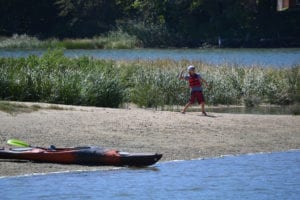
The cosigners of the document, Brookhaven Town Supervisor Ed Romaine (R) and Councilwoman Valerie Cartright (D-Port Jefferson Station); Suffolk County Leg. Kara Hahn (D-Setauket); state Assemblyman Steve Englebright (D-Setauket); and representatives from the Department of Environmental Conservation and Setauket Harbor Task Force left the agreement open-ended in the hopes that other branches of government and organizations will follow suit. The Setauket Harbor Task Force, a three-year-old community organization dedicated to improving water quality and the marine habitat in the harbor, spearheaded the agreement after finding local levels of government share a common interest in protecting and improving the harbor, though they were working concurrently rather than coordinately in some ways.
The memorandum was signed on a town dock off Shore Road in Setauket as part of the third Setauket Harbor Day, an annual event established by the task force in 2015.
The first mission laid out by the document is to develop a natural and cultural resource inventory of the harbor, which will be a springboard toward creating a management plan designed to achieve the preservation goals of Setauket Harbor and the roughly three-square miles surrounding it, known as the watershed, by acquiring lands within it, preserving historic sites, sharing ideas, engaging in open, ongoing discussions and contributing funds.
“You need to have a starting point and a vision for how all these pieces come together, and I think that’s what’s so great about this designation,” said George Hoffman, co-founder of the Setauket Harbor Task Force.
Englebright credited the task force with getting everyone involved and focused on the problems associated with Setauket Harbor, which among others include nitrogen pollution and the presence of coliform bacteria, mostly due to storm water runoff into waterways. The harbor falls within the larger Port Jefferson Harbor Complex, which lets out into the Long Island Sound.
In Sept. 2016, state Sen. John Flanagan (R-East Northport) announced he had secured a $1 million grant from the state to be used on enhancing the quality of the harbor’s waters, and the town dock on Shore Road. Englebright thanked Flanagan for his leadership in bringing issues regarding the harbor to light, but a recent annual study completed by Stony Brook University School of Marine and Atmospheric Sciences still shows the body of water is an area of concern.
“Some of the parcels we’re trying to protect are very vulnerable,” Englebright said. He added although the agreement is only an understanding and not law, he hopes that will change in the future. “What I’m hoping we can do within the context of a completed plan is that we can revisit that question at the state legislative level and write something that may have broad applicability. I think this whole plan has the potential to be a model.”
Romaine said he was excited for the possible benefits to the environment the agreement could bring, but also for the potential economic benefit of a healthier harbor.
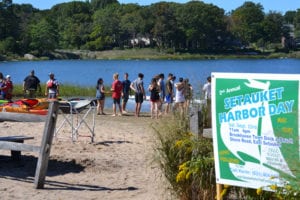
“The Harbor has been closed to shell fishing for more than 10 years,” he said. “We’d like to see it open up. We’d like to see some of the contaminants eliminated from this harbor so that it can restore itself. It’s very important to the town. I want to thank Steve because he’s done tremendous work, and we’ve worked together as colleagues for more than 35 years.”
Hahn suggested homes in the watershed could be prime candidates for Suffolk County’s Septic Improvement Program, an initiative that offers funds to homeowners within the county to replace outdated cesspools and septic system, which are major contributors to nitrogen pollution in waterways.
The federal government is not currently on board as part of the agreement, though DEC Regional Director Carrie Meek Gallagher said she expects that to change once a plan is in motion. The significance of the collaboration across party lines and municipality lines in lockstep with a community group like the task force was not lost on Cartright.
“This should be a prime example of how government on all levels should work together with the community,” she said.
Kevin McAllister, the founder of the nonprofit Defend H20, said while the agreement is a positive step, it will be largely symbolic if it is not followed up with action, and more importantly, funding.
“Providing greater funding for a host of projects, land acquisition, more protective zoning, denying shoreline hardening permits — these type actions, individually and collectively will define the resolve as put forth in the MOU,” he said in an email.
Englebright implored members of the public and community groups to not only get on board, but to take the additional step of holding elected officials to the terms of the agreement, including those who come after the incumbent lawmakers.
Setauket Harbor Day was held Sept. 23. Attendees had the opportunity to participate in free kayak tours, harbor and maritime history tours and hands-on harborside activities. There was also a sea creature touch-tank, children’s face painting and music.
State Assemblyman Steve Englebright (D-Setauket), Brookhaven Town Supervisor Ed Romaine (R), Town Councilwoman Valerie Cartright (D-Port Jefferson Station) and County Legislator Kara Hahn (D-Setauket) were on hand at the event hosted by the Setauket Task Force to sign a memorandum of understanding regarding a partnering to plan to conserve the historic and natural resources of the Setauket Harbor Watershed.
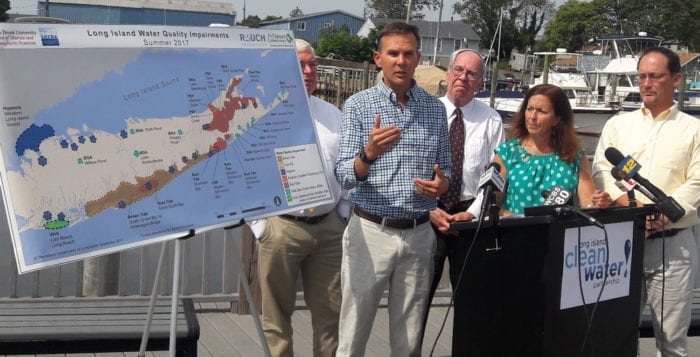
By Kyle Barr
There’s still something in the water — and it’s not a good kind of something.
Scientists from the Stony Brook University School of Marine and Atmospheric Sciences released an annual report highlighting the concern over the prolonged existence of toxic algae blooms, and a deficiency of oxygen in Long Island waters caused high levels of nitrogen.
Stony Brook Professor Christopher Gobler and several members of the advocacy collective Long Island Clean Water Partnership, a conglomerate of several Long Island environmental groups, revealed the findings of a study done from May to August.

“In order to make Long Island sustainable and livable, clean water needs to be established,” said Adrienne Esposito, the executive director of Citizens Campaign for the Environment. “The challenge has been very great over the last decade … though the problem, unfortunately, is getting a bit worse. Algae blooms and the degradation of water quality across Long Island are serious threats to Long Island’s health.”
On the North Shore, there are several severe cases of hypoxia, or a depletion of dissolved oxygen in water, which is necessary for sea life to survive. Cases were found in Stony Brook Harbor, Northport Bay, Oyster Bay and Hempstead Bay. Measured on a milligram per liter of water scale,any case of hypoxia below two milligrams per liter can be harmful to fish, and almost anything else living on the bottom of the bays.
There were also periodic outbreaks of blue-green algae in Lake Ronkonkoma and Stony Brook University’s Roth Pond. This algae releases a poison harmful to humans and animals, but Gobler said students at the university shouldn’t worry, because he and other scientists at Stony Brook are constantly monitoring the water, especially before the annual Roth Regatta.
“[If nothing is done] the areas could expand — it could get more intense,” Gobler said. “We use a cutoff of three milligrams per liter, which is bad, but of course you can go to zero. An area like Hempstead Harbor went to zero, [Northport and Oyster Bays] went to zero at some points in time. There’s a usual day-night cycle, so it’s at night that the levels get very, very low.”
“We have the problem growing worse, and it is going to get worse before it gets better.”
—Dick Amper
As a result of the possibility of hypoxia expanding, Gobler said he and other scientists have also been monitoring Port Jefferson Harbor and Setauket Harbor.
Though Setauket Harbor is not currently experiencing any problems with hypoxia or algae, the harbor has experienced periods of pathogens, like E. coli, some of which were born from runoff into the harbor, but others might have come from leakage of antiquated cesspools in the area, according to George Hoffman, a trustee of the Setauket Harbor Task Force, which is also a member of the Clean Water Partnership.
Next May the task force hopes to start monitoring directly inside Setauket Harbor. Runoff from lawn fertilizers can also increase the nitrogen levels in the harbor.
“If our problem isn’t hypoxia, we have a problem with pathogens,” Hoffman said in a phone interview. “Prevention is really [Dr. Gobbler’s] goal — to know what is happening and to start taking steps. I think people’s information levels [on the topic] are high in the surface waters that they live by.”
In addition to hypoxia and blue-green algae, some of the water quality problems found in the assessment were brown tides on the South Shore, rust tide in the Peconic bays and paralytic shellfish poisoning on the East End — all of which are also nitrogen level issues that can be traced back to cesspool sewage and fertilizers.
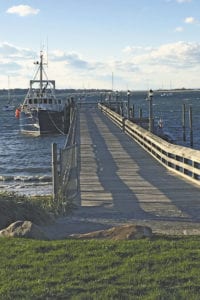
“Make no mistake about it, this is so big that even … still, we have the problem growing worse, and it is going to get worse before it gets better,” said Dick Amper, the director of The Long Island Pine Barrens Society. “What’s the solution to this problem? We have to do more.”
There have been several efforts to help curb water degradation on Long Island. New York Gov. Andrew Cuomo (D) signed legislation in April that put $2.5 billion toward clean water protection, improving water infrastructure and building new sewer systems in Smithtown and Kings Park, and adding a rebate program for those upgrading outdated septic systems.
Despite doing more, the repairs will take some time.
“This is going to be a long, long marathon,” said Kevin McDonald, the conservation project director at The Nature Conservancy said.
There is also worry that the U.S. Army Corps of Engineers — announcing the dumping of dredged materials into Long Island Sound — could compound the problem.
“We have more political funding and will try to implement solutions,” Esposito said. “The problems are getting worse, but the solutions are becoming clearer.”
EN PLEIN AIR: Gerard Romano of Port Jefferson Station captured this image of an artist painting plein air, a French expression meaning ‘In the open air,’ at Setauket Harbor in May using a Nikon D7100 with a Nikkor 18-200 zoom lens.
Send your Photo of the Week to [email protected].
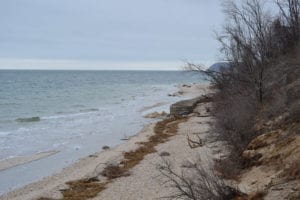
Sills Gully Beach, Shoreham:
Sills Gully Beach in Shoreham is a prime example of erosion due to storm events, according to Brookhaven Councilwoman Jane Bonner (C-Rocky Point). “When you harden the shoreline by constructing hundreds of linear feet of vertical retaining walls or bulkheads, you create a condition where the energy stored in the waves caused by tidal surge and storm events hits up against the hardening structure and reflects back to the Sound,” Bonner said. “These reflected waves cause scour at the base of the bulkhead and a loss of sand from the beach. To minimize this impact, both the New York State Department of Environmental Conservation and the town require armor stone, big rocks, in front of any bulkhead to dissipate the reflected wave surge, reducing the impact that bulkheads have on the beaches.” According to the councilwoman, bulkheads that were constructed in the past “increased the rate of erosion but also separated the beach from its natural sand source.” The practice led to either a narrow or non-existing beach during high tide. With recent changes of bulkheads being moved landward or reducing their elevations, plus the installation of armor stones, erosive impacts have been reduced, and “the beaches tend to be wider and more resilient to storm events.”
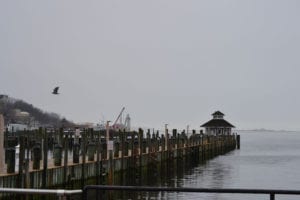
Port Jefferson Village:
Port Jefferson was originally known as Drowned Meadow because the area that now comprises most of the commercial district was a marsh that flooded every high tide, according to the book “Images of America: Port Jefferson,” written by Port Jefferson library staffers Robert Maggio and Earlene O’Hare. They wrote, “That flooding, and the steep hills and deep ravines that surrounded the marsh, made farming difficult, and the village grew slowly. In fact, by 1800, there were only a handful of houses.”
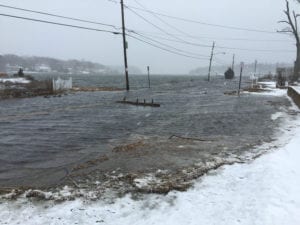
Setauket Harbor:
In the last decade, Shore Road along Setauket Harbor has flooded approximately a half a dozen times a year, which is more than in the past due to astronomical tides. “All coastal communities will be increasingly impacted by rising sea level, and sea level rise goes hand in hand with climate change,” George Hoffman of the Setauket Harbor Task Force said. “One way to identify the areas that will be impacted is to look at the areas that are now impacted by storms and astronomical tides. All the low-level shore areas in the Three Village community are the most vulnerable. And, they tend to be the areas that we like to go down to, along the shore, such as beaches and docks and harbor areas. It is projected that in the next hundred years as sea level continues to rise that we will see portions of Route 25A flooding during storm events that we haven’t seen before.”
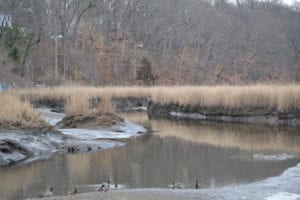
Nissequogue River, Smithtown:
According to Jan Porinchak, educator and naturalist, the Nissequogue River watershed would be threatened by rising sea levels due to climate change. The river consists of two main branches that start near the southern boundaries of the town in Hauppauge, and then the water flows into the Sound. “Rising sea levels will drown out the native marsh grasses which dissipate wave action and anchor the sediments comprising the shoreline,” Porinchak said. “With the marsh grasses such as Spartina removed, areas further inland would be threatened with shoreline loss from erosion.” Erosion can also have a negative impact on marine species. “With rising sea levels compromising marsh land vegetation, salt water can reach the roots of non-salt-tolerant woody plants further inland, which kills those plant species,” he said. “This creates a domino effect, resulting in yet more erosion when the roots of those plants are eliminated. Increased sediment from these eroded areas will wash into the Nissequogue and similar ecosystems. This sediment can negatively impact shellfish and other marine species, and fuel algae blooms to the widespread detriment of the marine food web.”
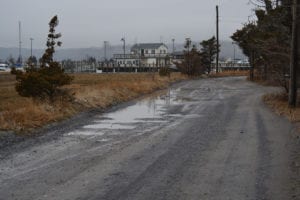
Long Beach, Smithtown:
Visitors to Smithtown’s Long Beach, a narrow land spit, will find an artificial berm to keep stormwater out during the winter. Many of the private roads slightly east of the town beach experience flooding when it’s high tide. Larry Swanson, interim dean of the School of Marine and Atmospheric Sciences at Stony Brook University, said the cause of the problem is the disruption of sediment due to a combination of rising sea levels and homeowners building sea walls to protect their property. “Long Beach is a spit that needs sediment supplied from the erosion of the bluffs of Nissequogue,” he said. “There are places where the supply is somewhat diminished to maintain sufficient elevation, perhaps where currents are stronger than elsewhere water can overflow.”
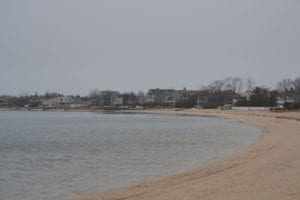
Asharoken, Huntington:
The incorporated village of Asharoken in the Town of Huntington provides the only essential land access way contacting the Eaton’s Neck peninsula to Northport, with its Asharoken Avenue. Due to hurricanes and nor’easters, the Long Island Sound side of the peninsula has experienced moderate to severe beach erosion. In 2015 the Asharoken village board took into consideration a U.S. Army Corps of Engineers-backed proposal to replenish the community’s eroding beaches. The plan consisted of creating a berm and dune system with groins on the northwestern end of the project area. The area includes properties on the Long Island Sound side of Asharoken Avenue. However, in January Asharoken officials voted to bring an end to the restoration project after many residents rejected part of the plan that included creating public access points at certain private properties, which would leave residents liable for any injuries or mishaps that happened when the public was on the shoreline of the property.
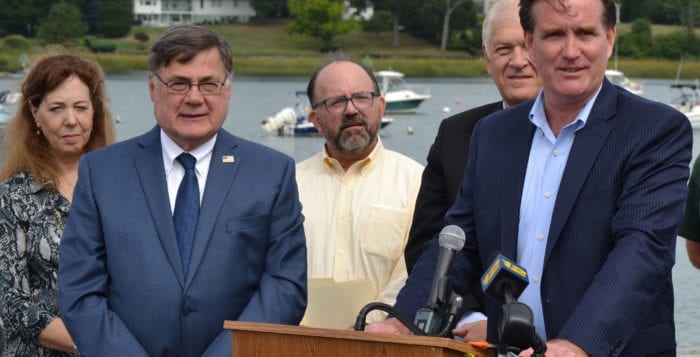
Advocates for the health of the Setauket Harbor were given an essential resource to aid in efforts to improve water quality in the North Shore port this week.
State Sen. John Flanagan (R-East Northport) announced he secured a $1 million grant from New York State for Brookhaven Town at a press conference Sept. 20 to be used to improve water quality in the harbor.
The announcement came on the heels of a recent water quality study of Setauket Harbor done by Cornell Cooperative Extension and commissioned by Brookhaven, which turned up troubling results. Setauket Harbor is part of the larger Port Jefferson Harbor complex.
“The recent water quality report commissioned by Brookhaven pointed out that Setauket Harbor has significant water quality issues caused mainly by road runoff from rain water flooding into the harbor after storms,” Laurie Vetere, chairwoman for Setauket Harbor Task Force, a volunteer group, said during the press conference.
“It’s clear that the harbor has some serious challenges.”
— George Hoffman
The grant will fund three projects relating to the harbor.
Half of the $1 million will go toward improvements to the dock. Forty percent will be used on storm water infrastructure improvements and the remaining $100,000 will be used to remove silt that has accumulated in the harbor and its water sources.
Nitrogen pollution and coliform bacteria have plagued Setauket Harbor in recent years.
“I don’t think we were surprised — the harbor has been struggling for years,” George Hoffman of the Setauket Harbor Task Force said in an email. “It has been closed to shell fishing for more than a decade and the main creek leading to the harbor is filled with sediment and not stopping contaminants in storm water from flowing into the harbor … it’s clear that the harbor has some serious challenges.”
Restrictions were placed on shell fishing in other Long Island waterways by the New York State Department of Environmental Conservation in 2015 because of water quality concerns.
Flanagan said the grant should be a step in the right direction to improve the harbor’s waters.
“Long Islanders are blessed with access to magnificent waterways like Setauket Harbor,” he said during the press conference. “That’s why it is important that all levels of government work together to preserve and protect these fragile ecosystems. This state funding will help support critical improvement projects to restore and revitalize this beautiful natural resource and it is my pleasure to partner with [Brookhaven Town Supervisor] Ed Romaine, the Town of Brookhaven and Setauket Harbor Task Force to help bring this project to reality.”
Flanagan, who is up for reelection in November, said in an interview following the press conference that environmental issues are an “A-1 priority” to his constituents.
“They deeply care about the environment,” he said. “I have a lot of coastal property in the district I’m fortunate enough to represent … it’s all important stuff.”
Romaine (R) has been an advocate for legislation to improve Long Island’s water quality for decades. In June, the town approved a law proposed by Romaine that prohibits structures being built within 500 feet of any Long Island waters from having cesspools or septic systems.
“I thank Sen. Flanagan for his strong advocacy on behalf of the Town to help us get started on improving the water quality in Setauket Harbor and the watershed that surrounds it,” Romaine said. “By acting now, I believe we can prevent further contamination, reverse the damage that has already been done and begin to restore this beautiful natural resource back to a healthy and environmentally sound waterway.”
